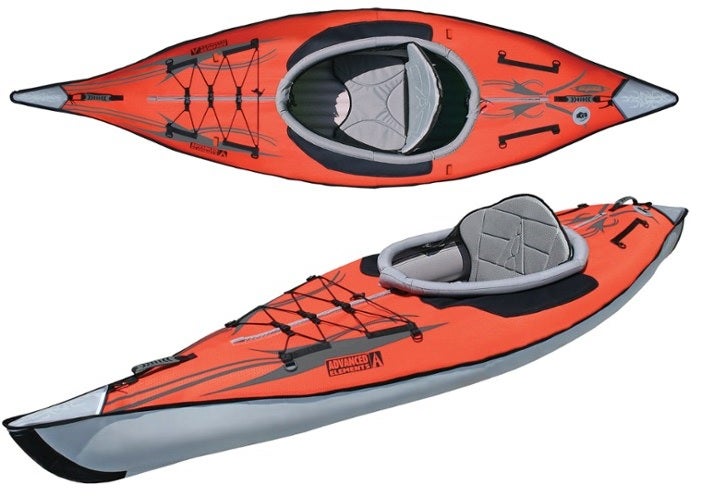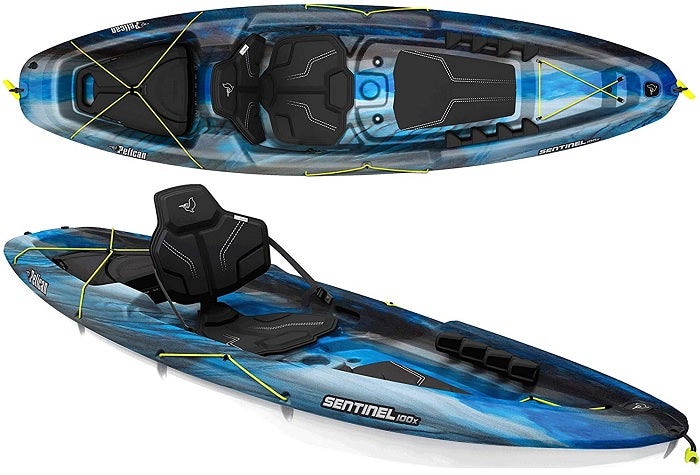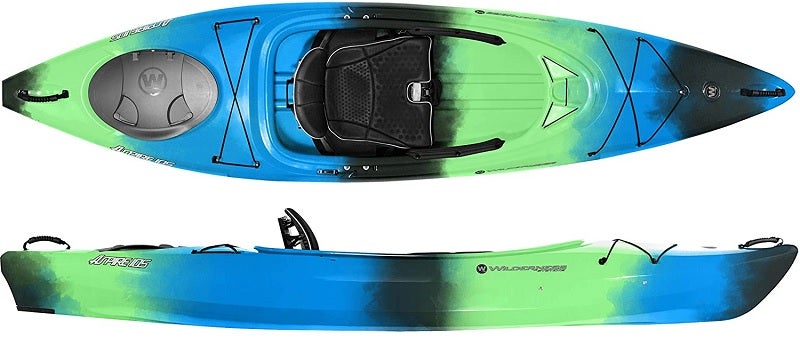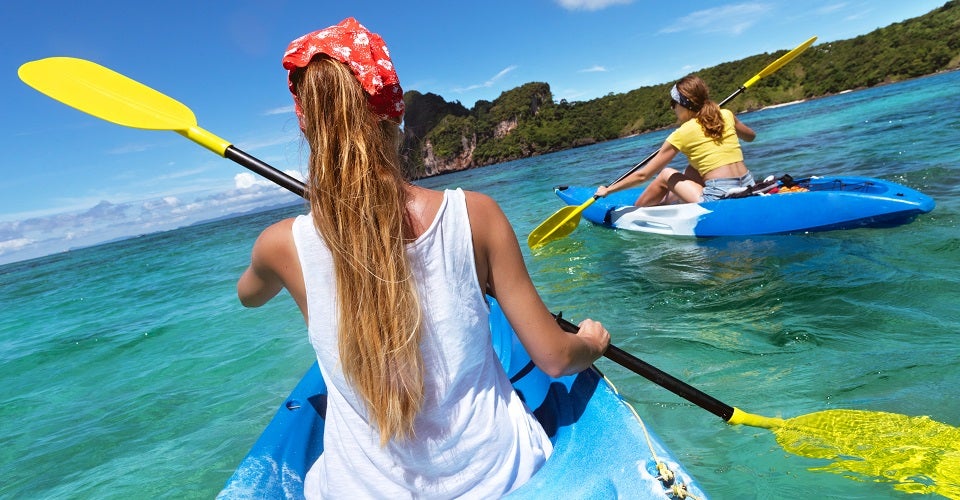
Our Editors independently research, test, and rate what we feel are the best products. We use affiliate links and may receive a small commission on purchases.
There’s a wonderful world to be discovered on the water. Kayaks are one of the easiest and most enjoyable ways to get around with human-powered endeavors on the water. Which kayaks are the best choice for the ladies is a tough question to answer, though.
In today’s article, we’ll take a look at some considerations for women’s kayaks. We’ll also recommend a few of the most accessible and most well-loved boats that rank highly for women’s outdoor pursuits.
Of course, there’s no hard and fast rule for what makes a kayak gender-specific. Instead, there are simply considerations each person should be aware of before making a purchasing decision.
Let’s take a look at considerations and options for women’s kayaks!
Best Kayaks For Women
| Ocean Kayak Women’s Venus Sit-On-Top Kayak | Advanced Elements AdvancedFrame Inflatable Kayak | Pelican Sentinel 100X Sit-on-Top Kayak | |
|---|---|---|---|
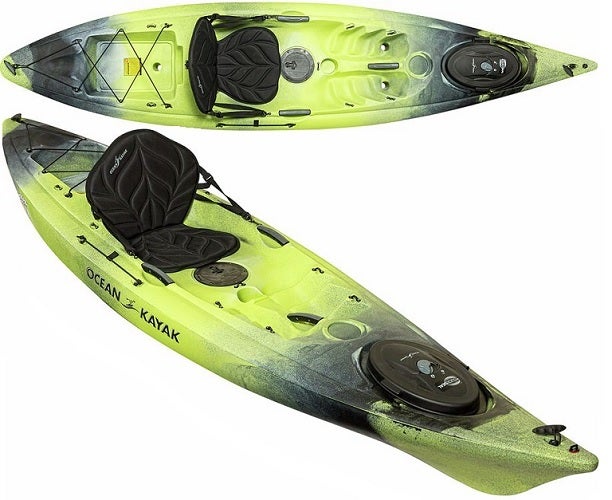 | |||
| Length: | 10′ 8″ | 10’ 5” | 9’ 6″ |
| Weight: | 44 Pounds | 36 Pounds | 42 Pounds |
| Weight Capacity: | 225 Pounds | 300 Pounds | 275 Pounds |
| Material: | Thermoformed ABS laminate | PVC/polyester/aluminum | Polyethylene |
| Rating: | 4.0 / 5.0 Stars | 4.4 / 5.0 Stars | 4.5 / 5.0 Stars |
| REI |
For more of my kayak gear recommendations, have a look through these popular Outside Pursuits guide links: Kayak Paddles, Kayak Anchors, Life Vests.
Quick Answer: The 10 Best Rated Women’s Kayaks For 2021
- Ocean Kayak Women’s Venus Sit-On-Top Kayak
- Advanced Elements AdvancedFrame Inflatable Kayak
- Pelican Sentinel 100X Sit-on-Top Kayak
- Old Town Vapor 10 Kayak
- Wilderness Systems Aspire Recreational Kayak
- Lifetime Tioga Sit-On-Top Kayak
- Lifetime 90899 Payette Sit-in Kayak
- Eddyline Sandpiper Kayak
- Wilderness Systems Tarpon 105 Sit-On-Top Kayak
- Delta Kayaks Delta 12 AR Kayak
Our reviews of the top rated women’s kayaks along with a comparison table and buyers guide will help you choose the right one for you.
Women’s Kayak Reviews
#1 Ocean Kayak Women’s Venus Sit-On-Top Kayak
- Length: 10′ 8″
- Weight: 44 Pounds
- Weight Capacity: 225 Pounds
- Material: Thermoformed ABS laminate
First up is the Ocean brand Venus kayak. This boat is made to be lightweight, agile, and easy to handle. It’s a great all-around kayak that can handle a variety of water and will grow with you as you learn.
As a flatwater recreational kayak this boat is made from Thermoformed ABS. That makes it both lightweight and durable. On top of that, it’s just 11’ long which makes it easy to cartop with just one person at a reasonable 44 pounds.
For fit and comfort they added in a women’s specific, ergonomic adjustable seat. Knee pads on the cockpit add more comfort and control. There are two hatches, one each in the front and rear for plenty of secure storage.
I really like the balance of weight, size, and comfort on this boat. That’s one reason it made a top pick on our list today. For the price it’s hard to beat, I think.
Best for beginners looking for a short, agile boat that can handle well on flat water.
#2 Advanced Elements AdvancedFrame Inflatable Kayak
- Length: 10’ 5”
- Weight: 36 Pounds
- Weight Capacity: 300 Pounds
- Material: PVC/polyester/aluminum
Inflatable boats make kayaking accessible to so many people who otherwise wouldn’t be able to do it with a traditional boat. Whether you don’t have room to store it or can’t transport a traditional boat, consider this inflatable option.
Everything about this boat is convenient and easy to use. All you need to do is unfold it and inflate it.
Inflation is done with Twistlok valves that can be used on many pumps in the industry. Up front is a rigid aluminum reinforced bow. Similarly the stern keeps things try with aluminum reinforced ribbing. Finfally, a tracking fin helps with paddling efficiency.
All this comes in an easy to transport bag and sets up quickly once you’re at the water.
Best for those who don’t want to struggle storing or transporting a traditional boat.
#3 Pelican Sentinel 100X Sit-on-Top Kayak
- Length: 9’ 6″
- Weight: 42 Pounds
- Weight Capacity: 275 Pounds
- Material: Polyethylene
Whether you want something light on the budget or an easy kayak for occasional trips this is an awesome option. Sit-on-top kayaks are popular for a reason – they’re convenient and fun!
While I wouldn’t call it feather light at 42 pounds for the modest 9’6″ of kayak, it certainly is easy to use. There’s an integrated fully padded, adjustable seat. Even better, the seat folds down flat for transport and storage.
Of course, little features like paddle keepers and molded in footwells provide the real finishing touches on this boat. We have to give a thumbs up for the removable storage compartment that makes for easy cleaning.
It’s hard to ignore the 5-year manufacturer’s warranty on this value-oriented boat. Best for the ease and convenience of a sit-on-top kayak at a great entry price.
#4 Old Town Vapor Kayak
- Length: 10′
- Weight: 44 Pounds
- Weight Capacity: 325 Pounds
- Material: Single layer polyethylene
Old Town is a name that has dominated the kayaking world for years. Their boats tend to strike a good balance of price and features which often makes them a top value pick for me.
First up we should take a look at the single layer polyethylene that this boat is made from. This gives the boat a lighter weight with more rigidity.
A full-size stern day well gives plenty of storage for gear along comfort flex seat and thigh braces makes for a great day of paddling.
The built in cup holders and paddle rests make it easy to take a drink and not drop a paddle. At 10 feet long it’s easy to control and great for flat water paddling. It’s a solid contender for a top spot on our list!
#5 Wilderness Systems Aspire Recreational Kayak
- Length: 10′ 6″
- Weight: 48 Pounds
- Weight Capacity: 400 Pounds
- Material: Polyethylene
We’re stepping up to the top tier of recreational boats with this 10.5 feet long premium kayak. Polished features, top notch seating, and lots of goodies make this boat a pick for those who spend lots of time on the water.
First up, be aware that this boat is longer and heavier than the nimble 9’ boats we looked at earlier. It will be a bit harder to transport and carry but the advantages are many.
For comfort they’ve put in an adjustable 3-stage seat that can be dialed in to your fit. Right in front of you at all times in the cockpit is a dashboard.
The built in thigh padding, padded adjustable foot rests along with a cup holder make for a comfortable day padding. At the rear of the boat is a hatch for storing lunch, clothes, or other gear (be sure to use a dry bag).
At 10.5 feet long this boat is going to be a bit more stable than shorter ones on our list. It’s made to track well and paddle over long distances on flat water. Great for long, regular trips.
Best for those who plan to use their kayak often for longer trips.
#6 Lifetime Tioga Sit-On-Top Kayak
- Length: 12’
- Weight: 45 Pounds
- Weight Capacity: 275 Pounds
- Material: Polyethylene
In the middle/longer of the length spectrum, this boat is both nimble and stable. While it may weigh a bit more than the shortest boats on our list, it’s a good middle ground at a decent price.
First off I’d just like to note that this boat does come with a Carlisle Magic Mystic paddle. This is a much nicer paddle than many entry level boats come with and is actually a nice addition to the value of this boat.
The stable flat bottom is perfect for beginner paddlers or anyone looking for flat water paddling. At the bow and stern of this boat is a well for gear and it’s backed up with straps to make sure your gear can’t fall out!
A small hatch in from of you provides storage for electronics, cameras or anything you want to keep handy and dry.
Best for regular use in flatwater with moderate chop.
#7 Lifetime 90899 Payette Sit-in Kayak
- Length: 9’8″
- Weight: 44 Pounds
- Weight Capacity: 250 Pounds
- Material: Polyethylene
Yes, one more Lifetime kayak. So, why another one? Because the price can’t be beat and the 9.75’ model stands out as a clear winner in the value game for sit inside kayaks.
Like the Tioga the price is hard to argue with, especially with the included paddle. However this one is a little over two feet shorter for that means it’s more nimble but tracking is not as good.
The large cockpit would allow you to even bring along a furry passenger if you like. The flat bottom means excellent stability but will suffer in any kind of chop. So for that reason this boat is best for flat water paddling.
Lifetime is known for their comfortable seats and the foot rests are adjustable to get maximum power from your strokes. The large hatch in the stern will store a decent amount of gear and shock cord rigging in the front gives you more gear storage.
Best for those on a budget looking for a shorter sit inside boat at a value.
#8 Eddyline Sandpiper Kayak
- Length: 12’
- Weight: 38 Pounds
- Weight Capacity: 350 Pounds
- Material: Carbonlite (ABS)
We’re stepping up into a whole new class of boats here. This 12’ kayak is made for efficiency and solid performance. Be ready to open your wallet if you want this increase in performance, however.
ABS the hull material of choice here. It’s a bit different from the norm but it creates a hull with extremely good performance. Using co-extruded ABS laminates allows this boat to have a glass-smooth hull exterior with tons of rigidity. That means great efficiency on the water.
As if good performance wasn’t enough, this 12’ long boat is featherlight compared to the polyethylene models. It comes in at just 38 pounds which is reasonably light and almost as easy to lift as the 9’ models we looked at earlier!
All that said, it features an adjustable rigid seat with a high back for comfort. Bow and stern hatches leave some room for gear and deck rigging adds to that.
Best for those who want a lightweight long kayak with great performance.
#9 Wilderness Systems Tarpon 105 Sit-On-Top Kayak
- Length: 10’ 6”
- Weight: 55 Pounds
- Weight Capacity: 325 Pounds
- Material: Polyethylene
Wilderness Systems makes the list again but this time they’re bringing us a sit-on-top boat. With a lot of the great features of Pungo I think this makes a top contender for our list.
With an updated design on this boat it’s overflowing with features. Fully adjustable footrests allow much greater personal fit than other molded-in footrests common in sit-on-top boats. In the cockpit is a fully padded adjustable seat that will keep up with any in its class.
At the stern of the boat is a huge mesh-covered storage well that allows for tons of gear. Up front is a storage hatch and gear lashing in the form of shock cord. Plus, right between your legs is a sealed watertight storage compartment perfect for a phone.
While the price tag is a bit higher than entry-level sit-on-top kayaks you’ll get what you pay for.
Best for the ease and convenience of a sit-on-top boat with tons of high-end features.
#10 Delta Kayaks Delta 12 AR Kayak
- Length: 12’
- Weight: 42 Pounds
- Weight Capacity: 320 Pounds
- Material: Thermoformed ABS
Another top notch boat for those who want to tackle long distances and regular trips is the Delta 12. With a generous cockpit and huge storage this boat is ready for long, comfortable paddles.
Another ABS boat, this kayak has great glide and efficiency. Plus, ABS has better UV resistance than cheaper materials. They’ve combined a V-shaped bow with a hybrid stern to get the best of tracking, stability, and efficiency. It’s a solid do-all boat for flatwater trips.
What really sets this kayak apart is the 3,000 cubic inches of sealed bulkhead storage at the bow and stern. These press-lock hatches have large openings so you can get your gear in and out with ease.
In the cockpit is a nice seat that uses the Delta index system. This creates 5 positions of personalized fitment that can help you stay comfortable.
Best for long trips where you need a ton of gear space for lunch, camping, or weather.
Women’s Kayak Comparison Table
| Women’s Kayak | Length | Weight | Weight Capacity | Material | Rating | |
|---|---|---|---|---|---|---|
| Ocean Kayak Women's Venus Sit-On-Top Kayak |  | 10′ 8″ | 44 Pounds | 225 Pounds | Thermoformed ABS laminate | 4.0 / 5.0 Stars |
| Advanced Elements AdvancedFrame Inflatable Kayak | 10’ 5” | 36 Pounds | 300 Pounds | PVC/polyester/aluminum | 4.4 / 5.0 Stars | |
| Pelican Sentinel 100X Sit-on-Top Kayak | 9’ 6″ | 42 Pounds | 275 Pounds | Polyethylene | 4.5 / 5.0 Stars | |
| Old Town Vapor Kayak | 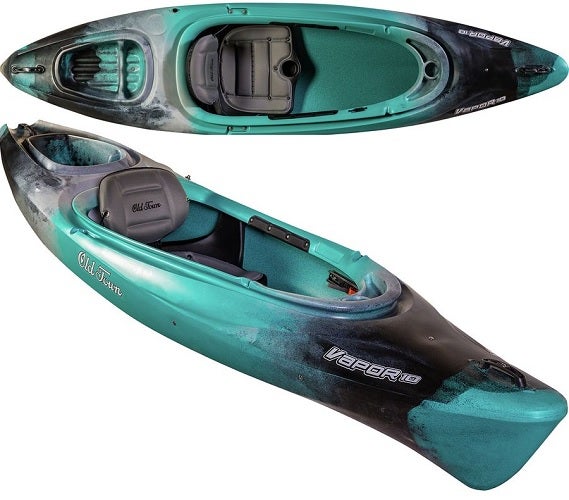 | 10′ | 44 Pounds | 325 Pounds | Single layer polyethylene | N/A |
| Wilderness Systems Aspire Recreational Kayak | 10′ 6″ | 48 Pounds | 400 Pounds | Polyethylene | 4.8 / 5.0 Stars | |
| Lifetime Tioga Sit-On-Top Kayak | 12’ | 45 Pounds | 275 Pounds | Polyethylene | 4.6 / 5.0 Stars | |
| Lifetime 90899 Payette Sit-in Kayak | 9’8″ | 44 Pounds | 250 Pounds | Polyethylene | 4.4 / 5.0 Stars | |
| Eddyline Sandpiper Kayak | 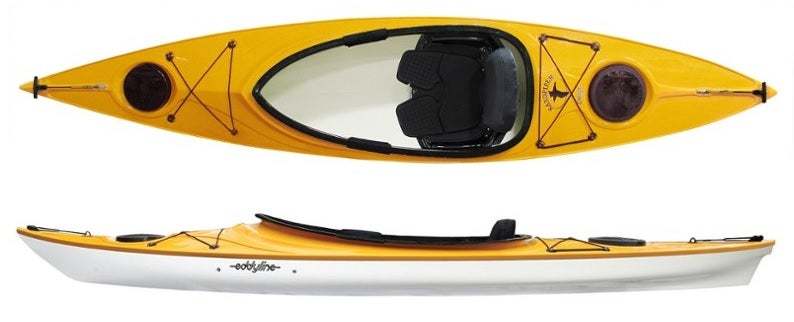 | 12’ | 38 Pounds | 350 Pounds | Carbonlite (ABS) | 4.8 / 5.0 Stars |
| Wilderness Systems Tarpon 105 Sit-On-Top Kayak | 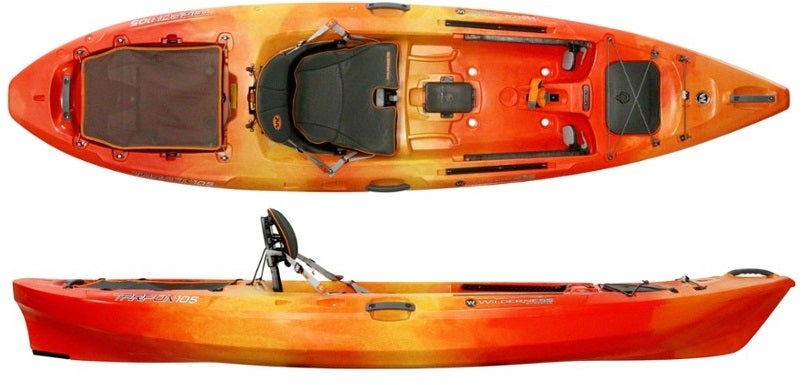 | 10’ 6” | 55 Pounds | 325 Pounds | Polyethylene | 4.8 / 5.0 Stars |
| Delta Kayaks Delta 12 AR Kayak | 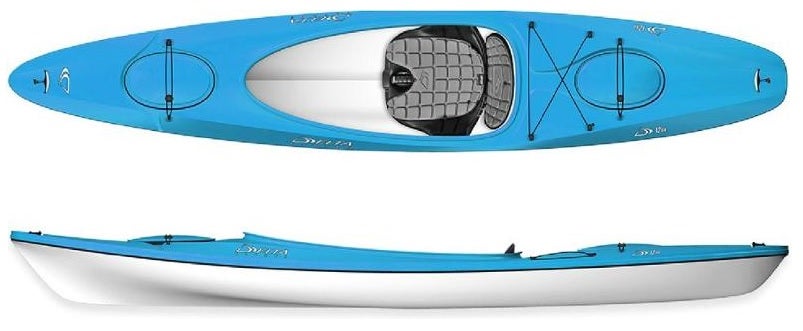 | 12’ | 42 Pounds | 320 Pounds | Thermoformed ABS | 4.8 / 5.0 Stars |
How to Choose the Best Women’s Kayak for You
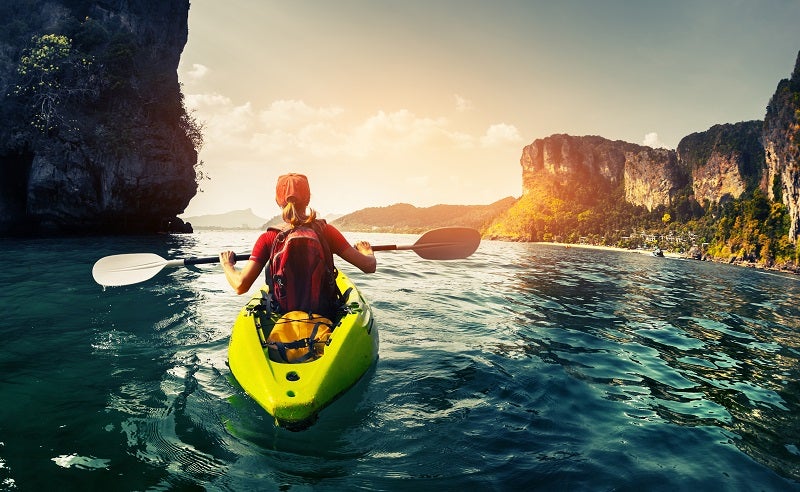
Now that you’re sure it’s time to buy a kayak, the next step is figuring out which one to buy! There are nearly unlimited types of kayaks for sale, so let me help you narrow it down and look at a few of the most common types of kayaks.
Kayak Types
Recreational Kayaks
Affordable polyethylene kayaks are probably the most common. These are made to be easy on the bank account and easy to use in the water
While these kayaks may be inexpensive, it doesn’t make them altogether bad choices. They’re great for occasional use or those on a budget.
Don’t expect one of these boats to hold up on open water or in nasty whitewater. They’re made primarily for easy-going flat water and gentle trips. Most people will start with a kayak in this category as they’re far and away the most versatile and attainable type for the beginner.
Touring Kayaks
Touring kayaks are made to handle long trips with ease. Their shape and design make them great for efficiently paddling very long distances while carrying gear. These boats are a little bit outside the scope of this article. Unless you’re an experienced paddler and plan to do long overnight trips, touring kayaks probably aren’t going to be a top pick.
Whitewater Kayaks
Whitewater kayaks, in many ways, are the opposite of touring kayaks. These short, agile boats are made to handle some of the roughest river conditions imaginable. Whitewater boats deserve an article of their own (and there are plenty) so we won’t go too deep into them here.
Suffice it to say that if you’re interested in a whitewater boat I highly encourage you to seek out a local outfitter for help. You’ll want to be sure that the boat you’re getting will be able to handle the type of paddling you plan to do and a local whitewater shop will be the experts in this area.
Inflatable Kayaks
These boats have a special place in my heart. On one hand I hate the idea of a blow up boat. On the other hand I love how convenient they are and how many transportation problems they solve!
Inflatable kayaks are nothing like pool toys you may invision. They use high pressure pumps to achieve a very rigid structure that will stand up to a lot of use (and abuse).
That doesn’t mean they cannot be punctured if you are really careless with them.
The primary advantage of course is that inflatable kayaks can fit into cars and SUVs without taking up space. They’re perfect if you can’t find a way to transport a traditional rigid kayak.
Some of the best among them even rival rigid kayaks for performance and features! If you want to see some more recommendations of inflatable kayaks, see my inflatable kayak reviews here.
Sit on Top Kayaks
Sit on top kayaks are awesome boats. They’re easy to get in and out, stable, durable, and self-bailing. That means you get a lot of advantages in a small package. That said, however, they’re relatively inefficient compared to many traditional kayaks.
There’s no cockpit on a sit on top kayak which means they can be cold and wet in rough water. You also sacrifice the ability to grip the sides of the kayak with your hips and knees. That makes them harder to control and more prone to tipping in rough conditions.
Sit on top kayaks, thanks to their flat open design, are easy to hop on and off while out for a paddle. Get in the water and wade through a shallow riffle, then hop back in the boat and enjoy your day!
Which is Better for You: Sit-in-Kayak or Sit-on-Kayak?

If you are still undecided which is better for you, answer these questions to make a determination.
- Will you be paddling in warm weather and water conditions? If you will be using the kayak in cold water/weather conditions, a site in kayak may be best for you.
- Are you a beginner and worried about the kayak tipping over? A sit in kayak is more stable due to the fact you are sitting lower in the kayak and will have a lower center of gravity providing more stability.
- Will you be kayaking in calm/sheltered water or in the ocean? A sit in kayak will keep you more protected from the elements and the ability attach a spray skirt giving you more protection from the elements that a sit in kayak.
Kayak Materials
Polyethylene is an affordable, semi-flexible kayak material common in recreational kayaks. While the material itself is prone to degrading in sunlight over long periods (don’t store it in sunlight) it’s also quite durable and holds up well to hard use bumping and scraping river objects.
Polycarbonate this material is slightly more efficient and performs better in the water than polyethylene. However, the price is usually slightly higher and some users complain that the material isn’t quite as forgiving to occasional abuse so treat it well!
Fiberglass is the material of choice for custom made boats and high-end kayaks. Because it can be made nearly glass-smooth it’s extremely efficient in the water. However, these boats require some special care and attention, plus they will drain your pocketbook compared to recreational kayaks.
As a note, there’s not a ton of difference between the final weight of a kayak made from polyethylene or polycarbonate.
Hull Designs
Rounded hulls are something of a U shape when viewed in cross-section. Many recreational boats borrow from this profile, and some add in a V shape as well for performance. Rounded hull boats can be tipsy when flat, but perform well when edged up at an angle.
V-Shaped are quick and cut the water well. They are pretty pointed compared to rounded hulls and are easily identifiable. These boats can be extremely finicky when sitting flat but have great efficiency and secondary stability.
Flat kayak hulls are great for slower speeds and higher stability. They’re most common on specialty whitewater kayaks and fishing kayaks. They offer tons of stability but they won’t paddle very efficiently due to the increased drag of the boat.
Tunnel/Pontoon hulls are a double shaped and look like a W when viewed from the cross-section. They’re slow and lack agility but offer the greatest stability of any hull shape available and track well in straight lines. These are perfect for fishing kayaks.
Chines
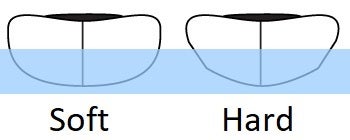
Chines refer to the shape of the kayak’s edges and the profile that the boat uses to define its shape in the water. Hard chines are sharp angles and edges, while soft chines are rounded gradual features.
Chines are defined as somewhere between hard and soft and show up in the area where the bottom of the boat meets the side. Hard chined boats almost seem to have a crease in the hull that runs along the length of the boat.
Hard chines make a boat good at primary stability and improve its ability to track in the water.
These hard chines aren’t as good in rough conditions, however.
Soft chines are better in rough water and perform well when the boat is up on edge. This makes soft chine boats great for agility and control in moving water.
Primary and Secondary Stability
Primary stability defines a boat’s steadiness on flat water with the boater sitting upright. Imagine you’ve just gotten in your boat and you’re sitting straight in a relaxed position. A boat with high primary stability will be very steady in this situation.
Secondary stability comes into play when you put the boat up on edge. Kayakers will do this purposely to control the boat in certain maneuvers or, sometimes, this happens when you lose your balance. Boats with great secondary stability will respond well to being tipped on edge, rather than feeling squirrelly.
For flat water or recreational paddling focus on primary stability. For moving water or whitewater you’ll want a boat with high secondary stability. All kayaks have a blend of the two components to some degree or another.
Kayak Rocker
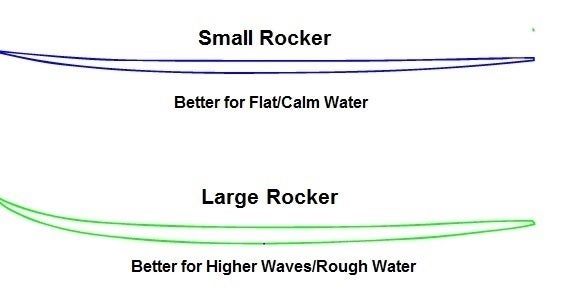
Rocker gives a kayak an upswept bow and stern (nose and tail). This “banana” shaped profile helps reduce the overall submerged profile of the boat. Kayaks with substantial rocker are very easy to turn because of this.
Rocker is great when you want to be able to turn. However, with less submerged profile rockered kayaks tend not to paddle easily in a straight line.
For recreational kayaks and the casual afternoon paddling trip, rockered boats might not make sense. They can take more effort to paddle straight and will want to turn every time you take a paddle stroke. They’re an excellent choice for maneuverability, however!
Kayak Lengths
Kayak lengths can range from 6’ or less in the case of whitewater boats up to 20’ in the instance of some sea kayaks.
I wouldn’t put too much consideration into kayak length when you’re choosing your first boat. If it’s for a recreational day of paddling or occasional use, you’ll likely not notice any difference between a 10’ boat and a 12’ boat.
That said, longer boats d+o paddle better in a straight line compared to shorter boats. Longer boats are harder to turn and less agile, however. There’s always a tradeoff.
If you value agility, tend toward a shorter boat. If you prefer long straight relaxing paddles then a longer boat is probably the sure choice.
As a final thought, shorter kayaks are easier to carry and transport. If you have a small vehicle, small storage space, or worry about being able to carry/lift your kayak then look for a lighter or shorter one.
Understanding Scupper Holes

What are those little holes in the frame of a sit on top kayak? Some think they are fishing rod holders. Other think they may be drainage holes for water. I’ve even heard that they’re supposed to make the boat lighter.
Well, it turns out that scupper holes are there to help the sit on top kayak drain any water that might get on deck. That means waves, splashes, capsizes, and paddle drips all can just drain right on out without any harm!
Of course, when you’re nice and dry and water squirts up through the scupper holes to get your bum wet, it can be annoying! To fix this problem you can try using scupper plugs, but if you get into trouble these plugs can prevent the scupper holes from self-bailing so be careful with their use!
Note: Scupper holes are also a great place to use a stake out stick or a scupper anchor pole for kayak anglers in shallow water.
Kayak Seats
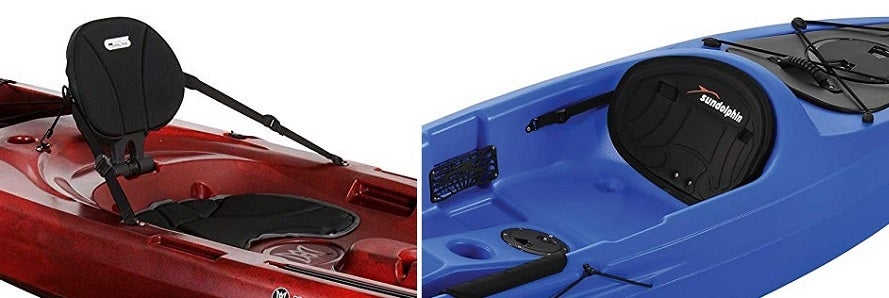
Kayaks are kind of notorious for bad seats but that’s not a rule. You’ll find plenty of boats with great seats out of the box but remember that you get what you pay for.
Fortunately you can get around a bad seat in most cases. Many kayaks have seats that can be easily replaced with aftermarket options!
When buying your kayak, if the seat looks questionable make sure it’s at least removable. If it doesn’t hold up to your needs you can always swap it out later and some aftermarket seats are just downright luxurious so I recommend it!
Note: If you choose a seat with a high back, pair it with a seat-friendly PFD (life jacket). A bulky lifejacket stuck between you and your seat is never comfortable.
Video: How to Paddle a Kayak
FAQs About Women’s Kayaks
Q: What kayak is the best choice for a beginner?
A: If you’re just getting started I’d recommend looking near the bottom of the price list. A recreational kayak makes a good choice for the beginner. These usually have balanced features that make them easy to learn on and affordable.
It’s not too hard to find a kayak under $500 that will fit the needs of a beginner. Look at something in the 9-10 foot range for ease of handling and transport.
Remember that beginner kayaks are usually meant for flatwater paddling. Keep your trips short and don’t challenge yourself too much when you’re getting started.
Q: How do I keep my gear safe?
A: Phones, keys, wallets, and clothing layers all run the risk of falling in and sinking to the bottom. In order to protect these (often expensive) items you’ll need a way to keep them safe.
Almost all kayaks, even the cheapest beginner kayaks, usually have deck rigging. These shock cord lashings are a good place for clothing layers but they won’t help with little things like keys and wallets.
I like to use waterproof cases such as those made by Pelican. Get one that can fit your phone and another that can fit your keys and other goodies. To keep these from floating away if you flip, use a carabiner to clip them on to the deck rigging or seat straps.
Q: How do I transport my kayak?
A: If you don’t have a truck you’ll have to get creative. There are solutions available for almost any type of kayak transportation you could imagine.
For vehicles with rails on top you can find several different kayak carriers to match these. If you don’t have rails, some vehicles can be modified to add rails so consider that option before giving up.
Trailers are other options. Kayak trailers come in sizes from one kayak to a dozen or more so if your vehicle has a hitch, consider a trailer. Additionally, if you have a smaller or lightweight boat you might be able to find a hitch extender or kayak carrier for the hitch of your vehicle.
Once you’re at your destination you’ll have to carry your kayak to the water. If it’s too big or too heavy, there are kayak carts which can help you manage the load.
Be sure to learn how to carry your kayak before you go out or you could hurt yourself attempting to lift the kayak.
Q: What makes a kayak specifically for women?
A: To be clear, kayaks rarely have features that are specifically necessary for various genders. That said, however, kayaks certainly have features that can make them easier to use for ladies in some situations.
Of course men and women have a few generalistic biological differences that tend to separate them physically. Regardless of your gender, being aware of your body, physical conditions, and personal needs will help you find the right boat for you.
On our list of women’s kayaks we’ve looked for boats that have been manufactured with fashionable colors that might appeal. Of course, ladies can most certainly choose from any color on the market.
Additionally, for those of smaller stature who might feel that they would struggle carrying or handling larger kayaks we’ve given some preference to smaller, lightweight kayaks. Again, ladies of any physical size or build can certainly choose from any of the large or small boats on our list.
One consideration is that, generally speaking, some ladies may have a harder time fitting into cockpits that are extremely narrow. Of course, this isn’t a universal truth, but beware that smaller lightweight kayaks can often have rather restrictive cockpits that can be hard even for the slimmest among us to wiggle into!
Q: How much should I expect to pay for a kayak?
A: Simple beginner kayaks can easily be found for less than $500 from many sources and many manufacturers. These boats are usually rather heavy and not necessarily the most efficient. That said, they’re great boats for beginners on a budget and they’ll make awesome kayaks for occasional recreational trips.
When you get up nearer the $1,000 range you’re usually looking at boats made with advanced hulls. These boats are usually purpose-built for various uses and often handle better and have great efficiency. They usually have much nicer seating and design that is comfortable for long trips.
At prices of $1,500 and above you can expect refined features, great efficiency, and boats built for advanced paddlers. While kayaks can be priced much higher, the vast majority of paddlers will find a boat under this price that can do anything they’d need.
Final Thoughts
Today we’ve taken a look at everything you need to know to pick out the best women’s kayak for your needs. Of course ladies can choose freely from any kayaks on the market but in this article we’ve tried to help shed some light on considerations that might matter to women.
Be sure to revisit the “how to choose” section before you settle on a boat. You’ll find a variety of women’s kayaks on our list that can serve as a faithful companion on your next adventure no matter your skill level!
How We Researched
To come up with the top women’s kayaks we researched a variety of sources for reviews such as REI, Dicks Sporting Goods, Cabelas and Backcountry along with our own personal experience.
We also consulted online magazines for product research and reviews to get as much unbiased information as we could. To help weed out fake reviews we used Fakespot.com to make sure we only looked at genuine reviews.
With so much quality gear available, we had to narrow it down based on what we felt were the best options for the price. The author, Casey Fiedler has been an avid kayaker and leads kayak camping trips during the summer months in his native state of Michigan.
To help narrow down the selection he used his personal experience along with recommendations from kayak tour guides and rental shops.
After extensive research, we came up with our list to help you choose the right one for you.
Sources

